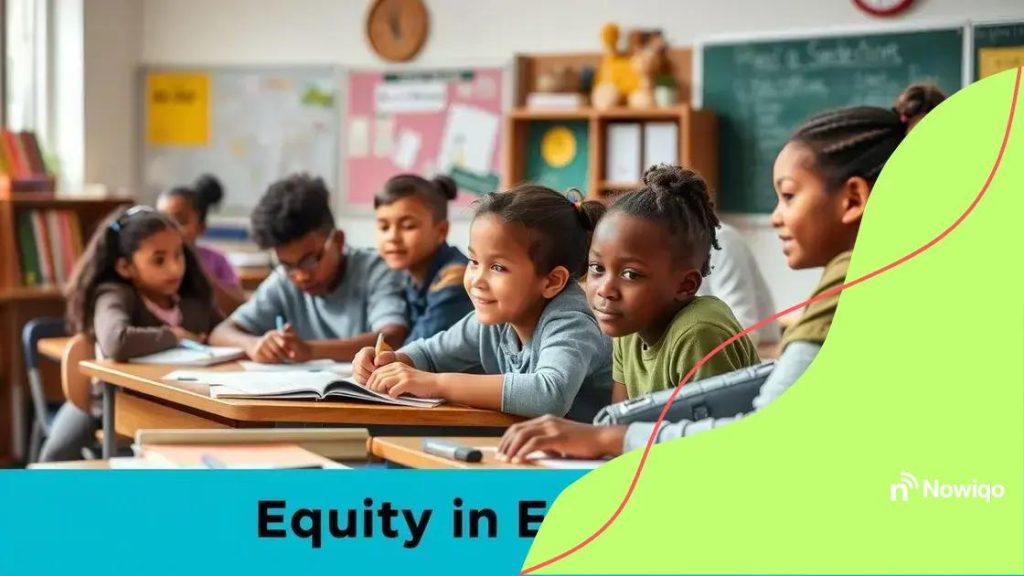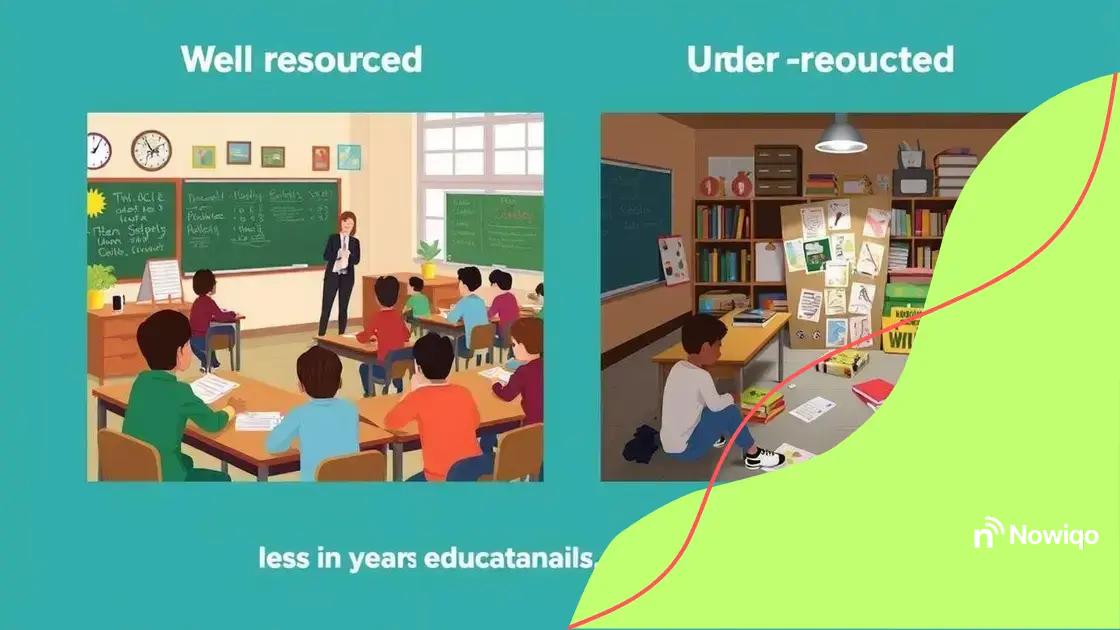Equity in education funding: understanding the gaps

Anúncios
Equity in education funding refers to the fair distribution of financial resources among schools to ensure all students have access to quality education and equal opportunities for success.
Equity in education funding plays a pivotal role in determining the quality of education students receive. Have you ever wondered how differences in funding can affect a child’s learning experience? Let’s dive into the various aspects of this critical topic.
Anúncios
Understanding equity in education funding
Understanding equity in education funding is essential for ensuring all students have the same opportunities to succeed. It considers how resources are distributed among schools and how this affects the learning environment.
Many factors influence funding distribution. Some schools receive more resources than others, leading to significant disparities. This can be due to differences in local taxes, state funding policies, or even the economic status of the communities they serve.
Key Factors Affecting Education Funding
Understanding what influences funding can help us address inequities. Here are some key factors:
Anúncios
- Local property taxes: Wealthier areas often generate more funding for schools.
- State funding formulas: Different states use various methods to allocate funds.
- Demographics: Schools in low-income areas may face more challenges in securing funding.
- Political decisions: Policies at the state and federal levels can impact how funds are distributed.
These factors create a cycle where inequitable funding leads to unequal educational experiences. When students attend schools with limited resources, their ability to learn and succeed is compromised. This raises questions about fairness and opportunity.
By focusing on equitable education funding, we can strive for a system where every child, regardless of their background, has access to quality education. Efforts to reform funding can take many forms, from adjusting state funding formulas to advocating for increased funding in under-resourced schools.
In communities across the country, voices are emerging to demand change. Parents, teachers, and students are calling for a fairer allocation of resources to ensure that every student has the tools they need to thrive. By understanding and addressing these issues, we move closer to achieving true equity in education.
Factors contributing to funding disparities
Funding disparities in education are affected by various factors. Understanding these elements can help highlight why some schools struggle. A few key influences include economic status, local tax structures, and state funding policies.
Economic Status
The economic situation of a community significantly impacts its school funding. Wealthier neighborhoods can generate more significant funding through local property taxes. This results in schools having better facilities and resources.
Local Tax Structures
Local taxes are a primary source of funding for schools, but not all communities are created equal. In areas where property values are low, schools often receive less funding, leading to essential resource shortages. This situation creates a cycle of underfunding.
State Funding Policies
Each state has different policies for education funding. Some states have equitable funding formulas that aim to distribute resources fairly. Others may focus more on local taxes, which exacerbate inequalities. Understanding these state-level decisions is crucial to recognizing funding disparities.
Moreover, demographics play a role in funding. Schools in areas with higher poverty levels often need more financial support to meet student needs. Yet, they frequently receive less funding than schools in more affluent areas. This leads to a widening gap in educational quality.
Advocacy for reform is critical. Without addressing these factors, equity in education funding will remain a distant goal. By shining a light on these discrepancies, communities can push for changes that ensure fairer funding practices.
Impacts of unequal education funding

The impacts of unequal education funding are profound and far-reaching. When schools lack adequate resources, students may not receive the quality education they deserve. This disparity creates various challenges that affect student outcomes and overall school performance.
One significant effect of unequal funding is the difference in educational resources. Schools that are better funded can provide updated technology, learning materials, and extracurricular activities. On the other hand, poorly funded schools often lack these basic necessities, making it difficult for teachers to engage students effectively.
Academic Performance
Research shows that unequal funding leads to differences in academic performance. Students in underfunded schools often struggle more with subjects like math and reading. They may have larger class sizes, which means less individual attention from teachers. This can negatively impact their learning experience and academic progress.
Access to Support Services
Students in need of support services, such as counseling or special education, often find these resources lacking in poorly funded schools. When schools cannot afford sufficient staff, students miss out on crucial support that can help them succeed. These deficiencies can lead to higher dropout rates and decreased college readiness.
- Students face barriers to learning due to lack of resources.
- Underfunded schools often experience higher teacher turnover.
- The quality of facilities and safety can vary greatly.
- Extracurricular opportunities are limited, affecting student engagement.
Additionally, the long-term effects of unequal funding can ripple into adulthood. Adults who attended poorly funded schools may struggle more to find stable jobs or pursue higher education. This cycle of poverty becomes harder to break, perpetuating the inequalities found in education.
Addressing these impacts requires a collective effort from communities, policymakers, and advocates. By raising awareness and promoting equitable funding solutions, we can work towards a more just education system where all students have the chance to thrive.
Steps towards equitable funding solutions
Finding equitable funding solutions for education is crucial to providing all students with the opportunities they deserve. There are several steps that communities, policymakers, and advocates can take to address funding disparities and create a more just education system.
1. Assess Funding Needs
The first step involves assessing the specific needs of schools and the communities they serve. This requires gathering data on student demographics, existing resources, and performance levels. Understanding where the gaps lie helps stakeholders develop targeted solutions.
2. Engage Stakeholders
Engaging various stakeholders is key to achieving equitable funding solutions. This includes parents, teachers, community leaders, and local organizations. By collaborating and sharing perspectives, stakeholders can advocate effectively for changes in funding policies.
3. Advocate for Policy Changes
Advocacy plays a vital role in addressing funding disparities. Advocates can push for state and federal legislation that prioritizes equitable funding formulas. This may involve adjusting how funds are allocated based on student needs rather than local property taxes.
4. Increase Public Awareness
Raising awareness about the impact of funding disparities is essential. When more people understand how inequitable funding affects students, they are more likely to support reform efforts. This can be achieved through community meetings, social media campaigns, and educational workshops.
5. Monitor and Evaluate Funding Changes
After implementing new funding strategies, it’s important to monitor their effectiveness. Evaluating how changes impact student outcomes will help determine what works best. This ongoing assessment can guide future funding decisions and ensure that they remain equitable.
By taking these steps, communities can work towards creating a fairer education system. Solutions must be tailored to meet the unique needs of each school while ensuring that every child has access to the resources they need to succeed.
Real-life examples of funding inequity
Real-life examples of funding inequity illustrate the challenges faced by many schools today. These disparities can significantly affect students’ education and overall opportunities.
One well-known example is found in urban versus rural schools. In many cities, schools in affluent neighborhoods often receive substantial funding, while those in low-income areas struggle to keep up. This can mean fewer resources, such as updated textbooks and technology.
Examples from Major Cities
In places like Los Angeles, schools in wealthy areas have access to advanced programs, while nearby schools in disadvantaged neighborhoods might lack basic supplies. Such inequities can widen the achievement gap among students.
Impact in Rural Areas
Rural schools face unique challenges as well. Many of these schools rely heavily on local property taxes, which may not generate enough funding. For instance, a rural high school in Appalachia might lack essential resources compared to a suburban school just a few miles away.
- Urban schools often have overcrowded classrooms due to high demand.
- Some schools can offer a wide range of extracurricular activities, while others cannot.
- Disparities can lead to differences in graduation rates and test scores.
- Access to college preparation resources varies greatly.
These examples underscore the urgent need for change. Without addressing these issues, students in underfunded schools will continue to face barriers to success. Advocating for equity in education is essential to ensure that every student has the opportunity to thrive, regardless of their background or location.
In conclusion, addressing funding inequity in education is essential for creating a level playing field for all students. Disparities in funding lead to significant challenges in learning, affecting resources, academic performance, and future opportunities. By understanding the factors contributing to these inequalities and advocating for change, communities can work together to ensure every child has access to quality education. Real-life examples demonstrate the urgency of this issue, and through collective action, positive change is possible. With equitable funding solutions, we can help every student thrive and achieve their potential.
\n\n\n
\n
\n
FAQ – Frequently Asked Questions about Equity in Education Funding
What is funding inequity in education?
Funding inequity refers to the unequal distribution of financial resources among schools, leading to significant differences in educational quality and opportunities for students.
How does funding inequity impact student performance?
Students in underfunded schools often have limited access to resources, leading to lower academic performance, higher dropout rates, and fewer opportunities for extracurricular activities.
What can communities do to address funding disparities?
Communities can assess funding needs, engage stakeholders, advocate for policy changes, and raise public awareness to promote equitable funding solutions.
Can real-life examples help us understand funding inequity?
Yes, real-life examples shed light on the urgent need for equitable funding by illustrating how disparities affect schools in different socioeconomic areas.